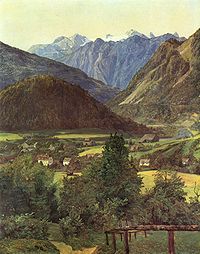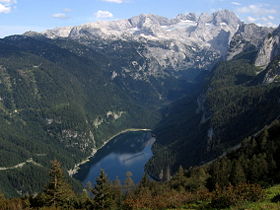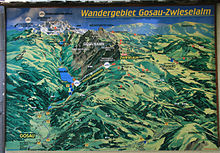- Hoher Dachstein
-
- Dachstein redirects here. For the French commune, see Dachstein, Bas-Rhin.
Hoher Dachstein
Hoher Dachstein from the north-west, with the Vorderer Gosausee in the foregroundElevation 2,995 m (9,826 ft) Prominence 2,136 m (7,008 ft) ranked 8th in the Alps Listing Ultra Translation high roof stone (German) Pronunciation German: [ˌhoː.ɐˈdaxʃtaɪn] Location Location Upper Austria / Styria, Austria Range Northern Limestone Alps Coordinates 47°28′32.5″N 13°36′23.2″E / 47.475694°N 13.606444°ECoordinates: 47°28′32.5″N 13°36′23.2″E / 47.475694°N 13.606444°E Geology Type Limestone Age of rock Triassic Climbing First ascent 1832 Peter Gappmayr (Gosau side) Hallstatt-Dachstein Salzkammergut Cultural Landscape * UNESCO World Heritage Site
Country Austria Type Cultural Criteria iii, iv Reference 806 Region ** Europe and North America Inscription history Inscription 1997 (21st Session) * Name as inscribed on World Heritage List
** Region as classified by UNESCOHoher Dachstein is a strongly karstic Austrian mountain, and the second highest mountain in the Northern Limestone Alps. It is situated at the border of Upper Austria and Styria in central Austria, and is the highest point in each of those states. Parts of the massif also lie in the state of Salzburg, leading to the mountain being referred to as the Drei-Länder-Berg ("three-state mountain"). The Dachstein massif covers an area of around 20×30 km with dozens of peaks above 2,500 m, the highest of which are in the southern and south-western areas. Seen from the north, the Dachstein massif is dominated by the glaciers with the rocky summits rising beyond them. By contrast, to the south, the mountain drops almost vertically to the valley floor.
Contents
Geology
The geology of the Dachstein massif is dominated by the so-called Dachstein-Kalk ("Dachstein limestone"), dating from Triassic times. In common with other karstic areas, the Dachstein is permeated by a rich cave system, including some of the largest caves in Austria, such as the Mammuthhöhle and the Hirlatzhöhle. Another significant tourist destination is the Eisriesenhöhle. The Dachstein is famous for its fossils, including megalodonts; the Linzer Weg leads over many such fossils, which are referred to as Kuhtritte ("cattle footprints").
Glaciers are uncommon in the Northern Limestone Alps, and those on the Dachstein — the Hallstätter Gletscher ("Hallstatt glacier") , the Großer Gosaugletscher ("great Gosau glacier") and the Schladminger Gletscher ("Schladming glacier") — are the largest, as well as being the northernmost and the easternmost in the whole of the Alps. Several smaller ice-fields also exist, such as the Kleine Gosaugletscher ("lesser Gosau glacier") and the Schneelochgletscher ("snow-hole glacier"). The glaciers are retreating rapidly, and may disappear entirely within 80 years. The Hallstatt glacier withdrew by 20 m in the year 2003 alone.
Climbing
The summit was first reached in 1832 by Peter Gappmayr, via the Gosau glacier, after an earlier attempt by Erzherzog Karl via the Hallstätter glacier had failed. Within two years of Gappmayr's success a wooden cross had been erected at the summit. The first person to reach the summit in winter was Friedrich Simony, on 14 January 1847. The sheer southern face was first climbed on 22 September 1909 by the brothers Irg and Franz Steiner.
Being the highest point of two different Bundesländer, the summit is a popular goal in both summer and winter. In fine weather as many as 100 climbers may be attempting the ascent, leading to congestion at key sections of the climb.
The best-known routes are
- Schulter-Anstieg: Simony Hütte - Hallstatt glacier - Dachsteinwarte - east ridge
- Randkluft-Anstieg: Simony Hütte - Hallstatt glacier - north-east face
- West ridge: Adamekhütte - Gosau glacier - Obere Windluke - west ridge
These routes require basic alpine equipment for crossing the glaciers and knowledge of climbing. The more interesting climbing routes are concentrated on the south face, the most famous among them being the Steinerweg (graded V) and the Pichlweg (graded IV).
See also
- Limestone Alps
External links
- "Dachstein". SummitPost.org. http://www.summitpost.org/page/150905.
- Dachstein West ski resort
- Dachstein at clasohm.com
World Heritage Sites in Austria East Cultural Landscape of Fertő / Neusiedlersee1 · Cultural Landscape of Wachau · Historic Centre of Vienna · Palace and Gardens of Schönbrunn · Semmering railway2
South Cultural Landscape of Hallstatt-Dachstein Salzkammergut2 · Historic Centre of the City of Graz and Schloss Eggenberg · Semmering railway2
West Cultural Landscape of Hallstatt-Dachstein Salzkammergut2 · Historic Centre of the City of Salzburg · Prehistoric Pile dwellings around the Alps3
1 Shared with Hungary · 2 Shared with other region/s · 3 Shared with France, Germany, Italy, Slovenia and Switzerland Ultra prominent peaks of Europe Scandinavia Galdhøpiggen • Kebnekaise • Jiehkkevárri • Snøhetta • Store Lenangstind • Sarektjåhkkå — On islands: Beerenberg • Hvannadalshnúkur • Newtontoppen • Novaya Zemlya HPWestern Europe Atlantic islands Alps Mont Blanc • Grossglockner • Finsteraarhorn • Wildspitze • Bernina • Hochkönig • Monte Rosa • Hoher Dachstein • Marmolada • Viso • Triglav • Barre des Écrins • Säntis • Ortler • Baldo • Gran Paradiso • Coca • Cima Dodici • Dents du Midi • Chamechaude • Zugspitze • Antelao • Arcalod • Grintovec • Großer Priel • Grigna Settentrionale • Bondone • Presanella • Birnhorn • Col Nudo • Pointe Percée • Montasch • Polinik • Tödi • Birkkarspitze • Wilder Kaiser • Grande Tête de l'Obiou • Cima Tosa • Hochtor • Grimming • Grand Combin • Tournette • Zirbitzkogel • KeschItaly Eastern Europe Carpathians: Gerlachovský štít • Parângu Mare • Moldoveanu • Peleaga — Crimea: Roman-Kosh — Urals: NarodnayaBalkans Mediterranean islands Caucasus Elbrus • Bazardüzü • Kazbek • Tebulosmta • Aragats • Dykh-Tau • Dyultydag • Kapudzhukh • Gora Addala Shukgelmezr • Shani • ShahdaghCategories:- Mountains of the Alps
- Mountains of Austria
- World Heritage Sites in Austria
- Dachstein Mountains
Wikimedia Foundation. 2010.



